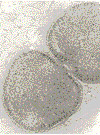Gloeobacter violaceus: Difference between revisions
| Line 45: | Line 45: | ||
Edited by Tracy Washington a student of [mailto:ralarsen@ucsd.edu Rachel Larsen] and Kit Pogliano | Edited by Tracy Washington a student of [mailto:ralarsen@ucsd.edu Rachel Larsen] and Kit Pogliano | ||
Jackisch, Y., Sandmann, G., Steiger, S., "Carotenoid biosynthesis in Gloeobacter violaceus PCC4721 involves a single crtI-type phytoene desaturase instead of typical cyanobacterial enzymes". ''Archives of Microbiology''. 2005. Volume 184 | |||
Jurgens, U., Schneider, S., "Cell Wall and Sheath Constituents of the cyanobacterium gloeobacter violaceus". ''Archives of Microbiology''. 1991. Volume 155. p. 312-318. | Jurgens, U., Schneider, S., "Cell Wall and Sheath Constituents of the cyanobacterium gloeobacter violaceus". ''Archives of Microbiology''. 1991. Volume 155. p. 312-318. | ||
Nakamura, Y., Kaneko, T., Sato, S., "Complete Genome Structure of Gloeobacter violaceus PCC 7421, a Cyanobacterium that lacks Thylakoids". ''DNA Research''. 2003. Volume 10. p. 137-145. | |||
Revision as of 06:50, 3 May 2007
A Microbial Biorealm page on the genus Gloeobacter violaceus
Classification
Higher order taxa
Bacteria; Cyanobacteria; Cyanophyceae; Chroococcales; Gloeobacteraceae
Species
|
NCBI: Taxonomy |
Violaceus
Description and significance
Describe the appearance, habitat, etc. of the organism, and why it is important enough to have its genome sequenced. Describe how and where it was isolated.
Include a picture or two (with sources) if you can find them.
Gloeobacter Violaceus is a rod-shape unicellular cyanobacterium that has been isolated from calcareous rocks in Switzerland (Nakamura et al, 2003). It is sensitive to strong light and is also a photoautotroph that contains chlorophyll a, caarotenoids, and phycobiliproteins. Molecular phylogenetic analysis of gloeobacter violaceus has revealed that this linage has diverged from other cyanobacteria and also, that it possesses oxygenic photosynthesis characteristics. Another distinct quality of gloeobacter violaceus is that its' composition of fatty acids is different because it has a high content of polyunsaturated fatty acids (PUFA). A large content of PUFA is unusual for because it was thought that instead there should be a larger composition of (sulfoquinovosyl diacylglycerol SQDG) to ensure photosystem stabilization. These remarkable qualities make it important to sequence the genome of Gloeobacter violaceus because it will reveal the genetic background that is responsible for the origin and evolution of oxygenic photosynthesis. The common method to determine the entire genome of gloeobacter violaceus is the use of shotgun method in conjunction with the bridging shotgun strategy (Nakamura et al, 2003).
Genome structure
Describe the size and content of the genome. How many chromosomes? Circular or linear? Other interesting features? What is known about its sequence? Does it have any plasmids? Are they important to the organism's lifestyle? Scientist have revealed that the genome of gloeobacter violaceus was comprised of a single circular chromosome that contained 4,659,019 base pairs. The average GC content was determined to be 62% and there was also no detection of plasmids during the course of sequencing. The total number of potential protein encoding genes for the entire genome was determined to be 4430 or on average one gene for evey 1052 base pairs. Only 610 genes of gloeobacter violaceus had matches to other cyanobacterial genomes, with about half of these having no known function. Also, about 20 % or 684 genes were found to be unique to this organism (Ussery 2004).
Cell structure and metabolism
Describe any interesting features and/or cell structures; how it gains energy; what important molecules it produces. Gloeobacter Violaceus is unicellular organism that exhibits atypical characteristics compared to other cyanobacterium. Its unusual characteristic is the lack of an internal thylakoid membrane system (Rippka et al. 1974). The rod shaped phycobilisomes of this organism are heavily packed and attach to the plasmic surface of they cytoplasmic membrane. The cell walls of gloeobacter violaceus are comprised of multiple layers. Starting from the exterior of the cell wall there is a sheath layer, then a double tracked structured outer membrane, intermediate cell wall layer that is electron dense, then lastly, a electron dense peptidoglycan layer. It gets its energy from oxygenic photosynthesis which is unique to this organism because usually the machinery for photosynthesis is found in the thylakoid membrane and not in the cytoplasmic membrane. Important products that G. violaceus produces are petJ and petE which are used for soluble electron transfer catalysts.
Ecology
Describe any interactions with other organisms (included eukaryotes), contributions to the environment, effect on environment, etc.
Pathology
How does this organism cause disease? Human, animal, plant hosts? Virulence factors, as well as patient symptoms.
Application to Biotechnology
Does this organism produce any useful compounds or enzymes? What are they and how are they used?
Current Research
Enter summaries of the most recent research here--at least three required
References
Edited by Tracy Washington a student of Rachel Larsen and Kit Pogliano
Jackisch, Y., Sandmann, G., Steiger, S., "Carotenoid biosynthesis in Gloeobacter violaceus PCC4721 involves a single crtI-type phytoene desaturase instead of typical cyanobacterial enzymes". Archives of Microbiology. 2005. Volume 184
Jurgens, U., Schneider, S., "Cell Wall and Sheath Constituents of the cyanobacterium gloeobacter violaceus". Archives of Microbiology. 1991. Volume 155. p. 312-318.
Nakamura, Y., Kaneko, T., Sato, S., "Complete Genome Structure of Gloeobacter violaceus PCC 7421, a Cyanobacterium that lacks Thylakoids". DNA Research. 2003. Volume 10. p. 137-145.


